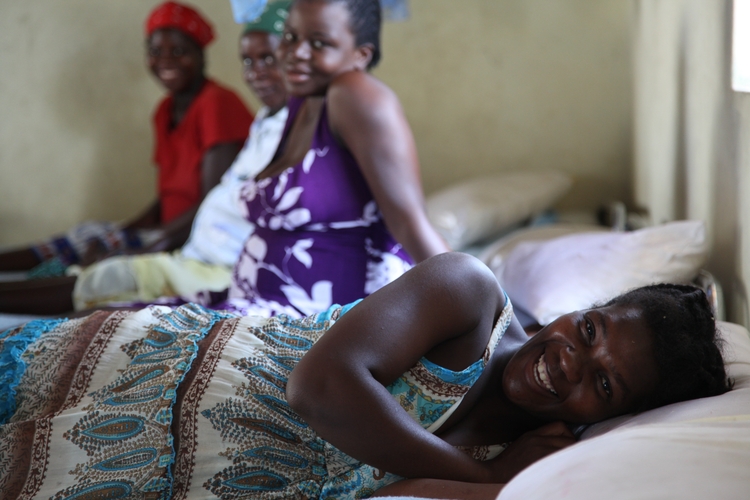
The Sunday Mail

Shamiso Yikoniko in Lupane
As the country’s health system continues facing challenges, the refurbishment of waiting rooms in hospitals has been received with cheers as it is believed to be one of the key ways to curb the continued maternal death toll at the country’s hospitals.
Official statistics indicated that, as of 2010, the maternity mortality rate saw at least 12 women die of pregnancy-related illnesses every day in Zimbabwe.
This was according to the Zimbabwe Health Demographic Survey 2010/2011, which saw at 960 deaths for every 100 000 live births.
Dr Bernard Madzima, the director of family health in the Ministry of Health and Child Care, summed up the chief reasons for this appalling statistic.
“Factors which have contributed to this unacceptable ratio of women dying in childbirth, or a pregnancy-related complication, was due to factors like limited access to maternal waiting homes, transport costs or lack of transport to health facilities and lack of skilled personnel in attendance at delivery,” he said.
These problems, which are peculiar to rural areas, arose in the 2000s as the country’s economy went into a plunge, leaving the country’s healthcare underfunded, understaffed and unable to provide proper maternal waiting homes and offer limited services only.
Since the 2000s era, Zimbabwe has witnessed an unparalleled deterioration of key maternal and new-born health indicators and is off track in achieving MDG 4 and 5.
The ZHDS shows that skilled attendance at birth declined from 73 percent in 1999 to 66 percent in 2010 and the institutional delivery from 72 percent to 65 percent in the same period.
Since 2007, most of these maternity waiting homes were dilapidated due to the collapse of the health system.
The UNFPA reproductive health specialist, Dr Edwin Mpeta, said the programme had received US$13 million from the EU and these funds would go a long way in refurbishing the waiting homes.
UNFPA has already started resuscitating rural waiting homes. And already 74 out of the 103 targeted rural health facilities have benefited.
The programme is meant to strengthen the waiting homes targeting 63 district hospitals and training of 800 health workers providing emergency childbirth care.
The cumulative figure for maternal deaths according to the weekly health surveillance report ending November 2, 2014 was at 278.
However, the Government aims to reduce the deaths to 174 per 100 000 live births by 2015, and the refurbishment exercise could be key in achieving that target.
In 2012, the UNFPA received a grant from EU to support the Ministry of Health and Child Care in revitalising maternity waiting homes and related services for the period of 2012-2015.
A recent visit to Matabeleland North showcased the strides being made by the Ministry of Health and Child Care and its partners such as the European Union (EU) and the United Nations Population Fund (UNFPA) to reduce both maternal and infant mortality rates.
St Luke’s Mission Hospital in Lupane district had a carrying capacity of 29 pregnant women against an average of 194 admissions in their waiting homes.
Due to the high demand, the hospital was using mattresses instead of beds in the maternity waiting homes to create more space for the pregnant women.
This had also resulted in some pregnant women sleeping in the open even during harsh weather conditions.
The overcrowding in the maternity waiting homes also put pressure on amenities like kitchen, toilets, washing area and storage.
Following the completion of the extensions, the bed-carrying capacity of the maternity waiting homes at St Luke’s Hospital has since increased from 90 to 160 even though demand seems to be increasing even more.
The district recorded 1 864 deliveries of which 1 609 were institutional deliveries and 195 were home deliveries between January and September 2014.
In the same period, the district recorded only three maternal deaths.
Dr Nkazimulo Tshuma, the acting district medical director for Matabeleland South, lauded the maternity waiting homes for significantly reducing maternal deaths.
“The district is experiencing a decline in maternal deaths since the maternity waiting homes have been refurbished.
“In 2008, the district recorded 11 maternal deaths, but as of September 2014, the maternal deaths are down to only three,” said Dr Tshuma.
For a district which caters for over 2 000 deliveries, the absence of a functional maternity home would put many expecting women in a quandary as many live far away from the health centre.
The waiting homes are mostly meant for expectant mothers who stay far away from health facilities and those with high-risk pregnancies. A mother of three children now, Ms Sithembiso Ncube (30) from Mtshakabandana village, which is 52 kilometres from Lupane centre, commended the refurbishing of the maternity waiting homes.
“I first came here in 2006 with my first pregnancy and the situation in the waiting homes was dreadful. We were overcrowded and some of the amenities that we have today didn’t exist then. During the rainy season the situation became dire,” she explained.
“Today I’m here to deliver my fourth child and as someone from the community we are grateful that as pregnant women we have a waiting home which addresses challenges like transport.”
The district, however, is now faced with a challenge of teenage pregnancy among school dropouts and out of school girls as teenagers constitute a large number of the pregnant mothers at the home.




